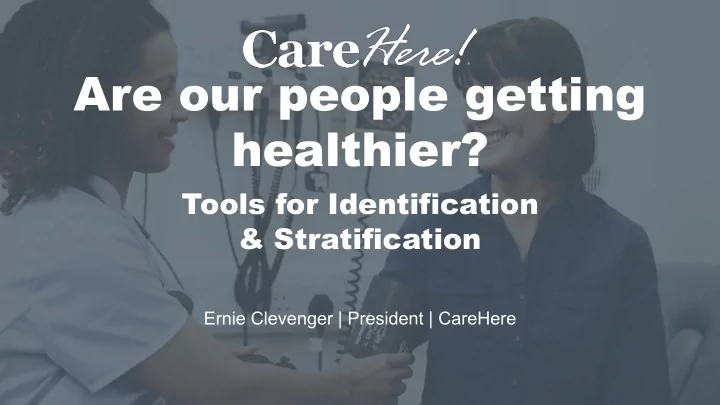

Are our people getting healthier? Tools for Identification & Stratification Ernie Clevenger | President | CareHere
Our approach for your employees and families: The CareHere Health Management Model IDENTIFY INTERVENE IMPROVE ü Annual Health ü Primary & Acute Care ü Improved Patient & Assessment (AHA) ü Occ Health & Workers Comp Client Experience ü Biometrics ü Rx Solutions ü Improved Clinical ü Lab data ü Health Promotion & Care Outcomes ü Claims data Coordination ü Improved Claims ü HR data ü Behavioral Health Trend & Productivity ü Data Analytics ü Physical Therapy & Chiropractic ü eHealth Center Solutions ü TeleHealth & eHealth Remote Monitoring 2
Patient Centric Focus 3
The ‘Report Card’ of your body: 28 Panel Venipuncture and Lab Values 4
Annual Health Assessment (AHA) 5
Monitoring risk movement for all members Risk Factors A risk factor is any attribute, characteristic or exposure of an individual that increases the likelihood of developing a disease or injury. Some examples of the more important risk factors are underweight, obesity, high blood pressure, high cholesterol and tobacco use. 1,492 Total Participants *Participants are trending towards a lower total number of risk factors from prior to recent reporting periods. 6
Monitoring risk movement for all members Risk Factors A risk factor is any attribute, characteristic or exposure of an individual that increases the likelihood of developing a disease or injury. Some examples of the more important risk factors are underweight, obesity, high blood pressure, high cholesterol and tobacco use. 1,492 Total Participants *Participants are trending towards a lower total number of risk factors from prior to recent reporting periods. 7
Measuring risk movement along time HbA1C 12 10 8 y = -0.0227x + 7.2212 6 4 2 0 -120 -100 -80 -60 -40 -20 0 8
Grouping members by condition cohorts 9
Grouping members by condition cohorts 10
R e m o t e m e m b e r s m o n i t o r i n g Hypertension Home Monitoring Program Participants with 30+ days in the program Aug 1 2018 - June 21, 2019 Total Participants Avg # of Readings per Participant Avg. Days in the program 356 88.7 129.7 # of Readings # Participants % Participants Avg Change Slope of Hypertension Values by days in the program Shows 25,262 273 76.7% -17.6 0.0002 Improvement 0.0001 Systolic Does not show 0.0000 6,309 83 23.3% 1.8 improvement -0.0001 -0.0002 Slope of Values 31,571 356 100.0% -13.1 Total -0.0003 -0.0004 Shows 24,666 276 77.5% -11.5 Improvement -0.0005 Diastolic -0.0006 Data shows that the longer a patient is Does not show 6,895 80 22.5% 1.2 in the Hypertension Home Monitoring improvement -0.0007 Program the more stable their Systolic and Diastolic slope of values are -0.0008 31,561 356 100.0% -8.7 -0.0009 Total 31-60 61-90 91 - 120 > 120 11
Clinical Metrics Reporting (cont’d) All Patients Diabetic Patients $440 $1,237 $376 $321 $642 $321 Not Engaged Engaged in Engaged & Completed Not Engaged Engaged in Engaged & Completed in Health Center Health Center Coaching Protocol in Health Center Health Center Coaching Protocol Hypertensive Patients Hyperlipidemic Patients $754 $1,014 $419 $377 $537 $262 Not Engaged Engaged in Engaged & Completed Not Engaged Engaged in Engaged & Completed in Health Center Health Center Coaching Protocol in Health Center Health Center Coaching Protocol 12
Is all this work making a difference? • Cost Per Employee Per Year (PEPY) • Trend line should be adjusted • Other factors can contribute to favorable results. 13
Th Thank you. Questions? Er Erni nie Cleveng nger EClevenger@C @CareHere.com 14
Recommend
More recommend